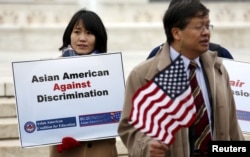Student Union
Lawsuit Against Harvard Could Unravel Diversity

A lawsuit filed against Harvard University that claims too few Asian-Americans are accepted to the vaunted college could do the opposite — eliminate race-conscious admissions nationally.
"It could end the use of racial preferences," said Ilya Shapiro, a senior Cato Institute fellow who specializes in constitutional studies.
The suit was filed by Students for Fair Admissions (SFFA) — a group started by Edward Blum, a legal activist who opposes the consideration of race in college and university admissions. Blum recruits plaintiffs, in this case Asian-American students, and pays their legal fees through donations that fund him.
The plaintiffs allege that Harvard's admissions process is unconstitutional because it uses racial quotas, makes race the dominant factor in admissions rather than one of many, and has not fairly considered race-neutral alternatives. They said it is biased against Asian-Americans and that the placements go to other minorities.
About 40,000 students apply to Harvard every year, but fewer than 6 percent are accepted. Asian-Americans make up 22.2 percent of students who were accepted into the class of 2022. According to the U.S. Census Bureau, Asian-Americans constitute 5 percent of the national population.
International students made up 12.4 percent of the same class. Nearly 50 percent of international students in the U.S. are from China or India.
"Asian-[American]s are held to a higher standard than whites, African-Americans and Hispanics," Blum told VOA.
Harvard denies this accusation, saying it considers a mix of factors, does not discriminate against Asian-Americans, and does not have quotas.
"Admissions officers seek ... to discern whether an applicant demonstrates outstanding and unusual intellectual ability, capacity for leadership, creative ability or athletic ability," reads a Harvard court document. "Admissions officers also look for individuals who have been able to transcend difficult circumstances by achieving academic, extracurricular and personal distinction in the face of hardship."
The school accuses SFFA of being "a litigation vehicle designed to further the ideological objectives of its founder, Mr. Blum" rather than "a true membership organization that can sue on behalf of its members."
In 2008, Blum enlisted Texan Abigail Fisher to sue the University of Texas, who alleged she was denied admission because of minority quotas. The school won that case.
Campus diversity is a contentious debate.
Racial quotas in university admissions were banned in 1978 by the U.S. Supreme Court when Allan Bakke won his case against the University of California, claiming he was not given a slot in medical school because they went to minority students. However, colleges and universities that receive any federal funding have been allowed to consider race in their admissions mix to ensure student populations are diverse, a move commonly known as affirmative action.
But that, too, is changing. In early July, the Trump administration withdrew guidelines issued by his predecessor, former President Barack Obama, that encouraged legal affirmative action.
"The general counsels of all of these schools are going to be talking to [their] presidents and deans and saying, 'Look, we're on notice now. We can't just hide behind this guidance. We have to look at what we're doing, how we're using race, to make sure that there are no race-neutral means to achieve the same diversity that we want,'" said Shapiro.
Opponents of affirmative action argue that students should be considered on merit alone. Still others say colleges should create a diverse class by considering economic status, meaning poor white students would be ranked higher than wealthy African- or Asian-American students.
Harvard said their admissions approach is holistic, meaning it looks at the whole person, including "the most exceptional academic, extracurricular, personal, and athletic ratings," according to a court filing.
Student Julie Yao, who transferred from Dickinson College in Pennsylvania to Barnard College in New York, said as a Chinese-American, she worries that the SFFA case will result in fewer seats for non-white students.
"It really infuriates me because it's almost like there are only a hundred seats for all students at a college," Yao said, "but there are only 20 open for diversity admissions."
"Why are we only fighting for so few spots?" she asked.
Her parents see the lawsuit differently.
"When I went home for a weekend this summer, my mom was actually telling me how her friends are telling people to fund this lawsuit," she said.
"Asian-Americans can be the victim of discrimination by a university in admissions," said Kimberly West-Faulcon, a civil rights attorney and law professor at Loyola Law School in Los Angeles. "The way you figure that out is to compare the Asian-American admission rate to the white admission rate."
Releasing too much information about their process "would disadvantage low-income applicants who can't afford the consultants and directly impair Harvard's ability to recruit and admit a diverse class each year," Harvard spokesperson Rachael Dane wrote in a statement.
The U.S. Department of Justice is investigating whether Harvard should be forced to reveal more details about its admissions process, and recently urged the court hearing the SFFA case to make more information in the lawsuit public.
"We are greatly encouraged that this [Trump] administration so far has asked the court to make public the information that Harvard turned over to us," said Blum. "We are delighted that an administration is demanding that there be full transparency for the American public."
Harvard questions the Justice Department's timing and approach.
"The Department cribs all but one of the cases it cites from SFFA's March 30 letter, and for certain issues, it provides no authority beyond simply citing SFFA's letter" for the request, William Lee, an attorney for Harvard, was quoted in the news site Politico.
Shapiro said he sees the case reaching the Supreme Court.
"The challengers here are unlikely to settle. In two years or so, we could see this at the Supreme Court," he said. If so, he predicts the court would rule in June 2020.
"Harvard will continue to vigorously defend its right, and that of all colleges and universities, to consider race as one factor among many in college admissions, which has been upheld by the Supreme Court for more than 40 years," Dane wrote.
International applicants don't have to worry about how the ruling will affect them.
"International applicants are compared to other international applicants," said West-Faulcon. The ruling "would not affect the admissions of an international student applying from an Asian country."
See all News Updates of the Day
- By VOA News
Competition grows for international students eyeing Yale

It’s tough to gain admission to Yale University, and it’s getting even tougher for international students as standout students from around the world set their sights on Yale.
The Yale Dale News, the campus newspaper, takes a look at the situation here.
- By VOA News
Student from Ethiopia says Whitman College culture made it easy to settle in

Ruth Chane, a computer science major from Ethiopia, writes about her experiences settling into student life at Whitman College in the U.S. state of Washington.
"The community at Whitman College made sure I felt welcomed even before I stepped foot on campus," she says.
- By VOA News
Claremont Colleges student gets a shock when she heads home to Shanghai
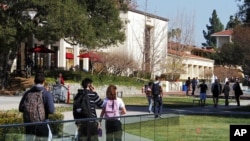
In The Student Life, the student newspaper for the Claremont Colleges, a consortium of five liberal art colleges and two graduate schools in Claremont, California, student Rochelle Lu writes about readjusting to her Shanghai home after spending a semester in the United States.
- By VOA News
Cedarville University aims to ease transition for international students
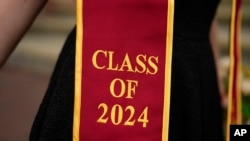
Cedarville University in the U.S. state of Ohio says it’s got more than 140 international students representing 44 countries.
Here, the school interviews Jonathan Sutton, director of international student services. He talks about his job and the opportunities for international students on campus.
- By VOA News
Morehouse College offers prospective students tips on applying and thriving
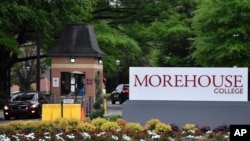
Morehouse College, a private, historically Black liberal arts college in the U.S. state of Georgia, offers a guide for international students interested in attending the school.
Among the tips to apply and thrive at Morehouse:
- Take advantage of the school’s orientation program
- Turn to the school’s Center for Academic Success for tutoring, support and more
- Immerse yourself in campus life via clubs and societies
- By Reuters
US reviews Columbia University contracts, grants over antisemitism allegations

The administration of President Donald Trump said on Monday it will review Columbia University's federal contracts and grants over allegations of antisemitism, which it says the educational institution has shown inaction in tackling.
Rights advocates note rising antisemitism, Islamophobia and anti-Arab bias since U.S. ally Israel's devastating military assault on Gaza began after Palestinian Hamas militants' deadly October 2023 attack.
The Justice Department said a month ago it formed a task force to fight antisemitism. The U.S. Departments of Health and Education and the General Services Administration jointly made the review announcement on Monday.
"The Federal Government's Task Force to Combat Anti-Semitism is considering Stop Work Orders for $51.4 million in contracts between Columbia University and the Federal Government," the joint statement said.
The agencies said no contracting actions had been taken yet.
"The task force will also conduct a comprehensive review of the more than $5 billion in federal grant commitments to Columbia University."
The agencies did not respond to requests for comment on whether there were similar reviews over allegations of Islamophobia and anti-Arab bias.
Columbia had no immediate comment. It previously said it made efforts to tackle antisemitism.
College protests
Trump has signed an executive order to combat antisemitism and pledged to deport non-citizen college students and others who took part in pro-Palestinian protests.
Columbia was at the center of college protests in which demonstrators demanded an end to U.S. support for Israel due to the humanitarian crisis caused by Israel's assault on Gaza. There were allegations of antisemitism and Islamophobia in protests and counter-protests.
During last summer's demonstrations around the country, classes were canceled, some university administrators resigned and student protesters were suspended and arrested.
While the intensity of protests has decreased in recent months, there were some demonstrations last week in New York after the expulsion of two students at Columbia University-affiliated Barnard College and after New York Governor Kathy Hochul ordered the removal of a Palestinian studies job listing at Hunter College.
A third student at Barnard College has since been expelled, this one related to the occupation of the Hamilton Hall building at Columbia last year.
Canada’s immigration overhaul signals global shift in student migration
From Europe to North America, nations are tightening their immigration policies. Now Canada, long seen as one of the world's most welcoming nations, has introduced sweeping changes affecting international students. The reforms highlight a growing global trend toward more restrictive immigration policies. Arzouma Kompaore reports from Calgary.
Trump administration opens antisemitism inquiries at 5 colleges, including Columbia and Berkeley
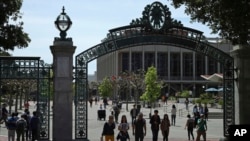
The Trump administration is opening new investigations into allegations of antisemitism at five U.S. universities including Columbia and the University of California, Berkeley, the Education Department announced Monday.
It's part of President Donald Trump's promise to take a tougher stance against campus antisemitism and deal out harsher penalties than the Biden administration, which settled a flurry of cases with universities in its final weeks. It comes the same day the Justice Department announced a new task force to root out antisemitism on college campuses.
In an order signed last week, Trump called for aggressive action to fight anti-Jewish bias on campuses, including the deportation of foreign students who have participated in pro-Palestinian protests.
Along with Columbia and Berkeley, the department is now investigating the University of Minnesota, Northwestern University and Portland State University. The cases were opened using the department's power to launch its own civil rights reviews, unlike the majority of investigations, which stem from complaints.
Messages seeking comment were left with all five universities.
A statement from the Education Department criticized colleges for tolerating antisemitism after Hamas' Oct. 7, 2023, attack on Israel and a wave of pro-Palestinian protests that followed. It also criticized the Biden administration for negotiating "toothless" resolutions that failed to hold schools accountable.
"Today, the Department is putting universities, colleges, and K-12 schools on notice: this administration will not tolerate continued institutional indifference to the wellbeing of Jewish students on American campuses," said Craig Trainor, the agency's acting assistant secretary for civil rights.
The department didn't provide details about the inquiries or how it decided which schools are being targeted. Presidents of Columbia and Northwestern were among those called to testify on Capitol Hill last year as Republicans sought accountability for allegations of antisemitism. The hearings contributed to the resignation of multiple university presidents, including Columbia's Minouche Shafik.
An October report from House Republicans accused Columbia of failing to punish pro-Palestinian students who took over a campus building, and it called Northwestern's negotiations with student protesters a "stunning capitulation."
House Republicans applauded the new investigations. Representative Tim Walberg, chair of the Education and Workforce Committee, said he was "glad that we finally have an administration who is taking action to protect Jewish students."
Trump's order also calls for a full review of antisemitism complaints filed with the Education Department since Oct. 7, 2023, including pending and resolved cases from the Biden administration. It encourages the Justice Department to take action to enforce civil rights laws.
Last week's order drew backlash from civil rights groups who said it violated First Amendment rights that protect political speech.
The new task force announced Monday includes the Justice and Education departments along with Health and Human Services.
"The Department takes seriously our responsibility to eradicate this hatred wherever it is found," said Leo Terrell, assistant attorney general for civil rights. "The Task Force to Combat Anti-Semitism is the first step in giving life to President Trump's renewed commitment to ending anti-Semitism in our schools."
- By VOA News
STEM, business top subjects for international students
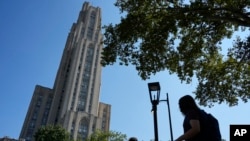
The Times of India breaks down the most popular subjects for international students to study in the U.S.
STEM and business lead the pack. Read the full story here. (January 2025)
- By VOA News
Safety and visa difficulties among misconceptions about US colleges

U.S. News & World report addresses some of the misconceptions about U.S. colleges and universities, including the difficulty of getting a visa.
Read the full story here. (January 2025)
- By VOA News
Work opportunities help draw international students to US schools
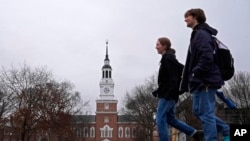
US News & World Report details the three top factors in foreign students' decision to study in the U.S. They include research opportunities and the reputation of U.S. degrees. Read the full story here. (December 2024)
- By VOA News
British student talks about her culture shock in Ohio

A British student who did a year abroad at Bowling Green State University in Ohio talks about adjusting to life in America in a TikTok video, Newsweek magazine reports.
Among the biggest surprises? Portion sizes, jaywalking laws and dorm room beds.
Read the full story here. (December 2024)
- By VOA News
Harvard's Chan School tells international students what to expect
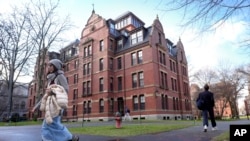
Harvard's T.H. Chan School of Public Health reaches out to international students by detailing the international student experience at the school.
Learn more about housing, life in Boston and more here.
- By Reuters
China unveils plan to build 'strong education nation' by 2035

China issued its first national action plan to build a "strong education nation" by 2035, which it said would help coordinate its education development, improve efficiencies in innovation and build a "strong country."
The plan, issued Sunday by the Communist Party's central committee and the State Council, aims to establish a "high quality education system" with accessibility and quality "among the best in the world."
The announcement was made after data on Friday showed China's population fell for a third consecutive year in 2024, with the number of deaths outpacing a slight increase in births, and experts cautioning that the downturn will worsen in the coming years.
High childcare and education costs have been a key factor for many young Chinese opting out of having children, at a time when many face uncertainty over their job prospects amid sluggish economic growth.
"By 2035, an education power will be built," the official Xinhua news agency said, adding that China would explore gradually expanding the scope of free education, increase "high-quality" undergraduate enrolment, expand postgraduate education, and raise the proportion of doctoral students.
The plan aims to promote "healthy growth and all-round development of students," making sure primary and secondary school students have at least two hours of physical activity daily, to effectively control the myopia, or nearsightedness, and obesity rates.
"Popularizing" mental health education and establishing a national student mental health monitoring and early warning system would also be implemented, it said.
It also aims to narrow the gap between urban and rural areas to improve the operating conditions of small-scale rural schools and improve the care system for children with disabilities and those belonging to agricultural migrant populations.
The plan also aims to steadily increase the supply of kindergarten places and the accessibility of preschool education.
- By VOA News
A look at financial aid options for international graduate students in US

The Open Notebook, a site focusing on educating journalists who cover science, has complied a list of U.S. graduate program financial aid information for international students.




